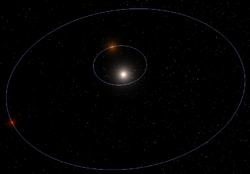Y Sextantis
 Possible architecture for Y Sextantis' multiple system | |
| Observation data Epoch J2000.0 Equinox J2000.0 | |
|---|---|
| Constellation | Sextans |
| Right ascension | 10h 02m 47.9589s |
| Declination | +01° 05′ 40.346″ |
| Apparent magnitude (V) | 9.97 |
| Characteristics | |
| Spectral type | F8V/F8.5V-VI |
| Astrometry | |
| Distance | 361.4 ly (110.86 pc) |
| Details | |
| Mass | 1.21/0.22[1] M☉ |
| Radius | 1.4/0.85 R☉ |
| Luminosity | 2.6/0.96 L☉ |
| Temperature | ≈6200 K |
| Other designations | |
Y Sex, BD+01 2394, HIP 49217, HD 87079 | |
Y Sextantis (Y Sex) is a W Ursae Majoris variable eclipsing contact binary star system located roughly at 360 light years from the Sun, whose two component stars share a common outer layer. Because the two components share their outer layers as the components of W Ursae Majoris do, they have the same stellar classification, and are classified as yellow F-type main sequence dwarfs. The components take 0.419822800 days (roughly 10 hours) to revolve around common barycentre. Orbital period variations would suggest the presence of additional perturbing objects, one of them likely substellar.
Perturbing third (and fourth?) body
Orbital period variations suggest the presence of one more perturbing unseen object.[1] The authors He & Qian have estimated two possible orbital periods and minimum masses for unseen companions: the former cyclic oscillation would occur every 51.22 years (with amplitude of 0.0218 days) being caused by a low-mass stellar companion (likely a M dwarf star), whereas the latter would consist in a 32.1 years period and the unseen object could likely be substellar.
| Companion (in order from star) |
Mass | Semimajor axis (AU) |
Orbital period (days) |
Eccentricity | Inclination | Radius |
|---|---|---|---|---|---|---|
| b (unconfirmed) | ≥240 (0.24 Solar masses) MJ | 49.0±3.9 | ≈18695 | ? | — | — |
| c (unconfirmed) | ≥43 MJ | 58.9±6.7 | ≈11716 | ? | — | — |
References
- 1 2 He & Qian (2007). "An Orbital Period Investigation of the WUMa-Type Binary Y Sextantis". Publications of the Astronomical Society of Japan. 59 (6): 1115–1119. arXiv:0908.4521
 . Bibcode:2007PASJ...59.1115H. doi:10.1093/pasj/59.6.1115.
. Bibcode:2007PASJ...59.1115H. doi:10.1093/pasj/59.6.1115.